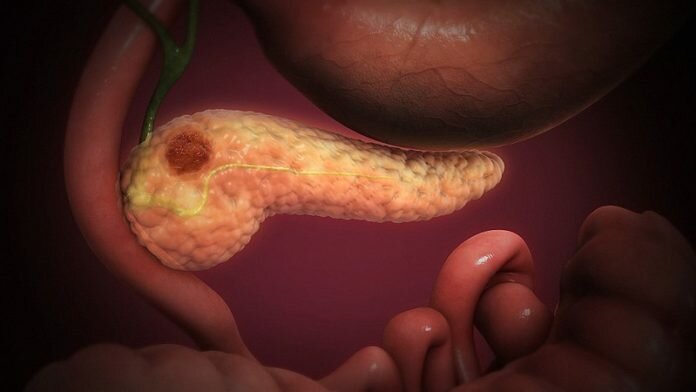
An international team of scientists has found that adding an already clinically approved component of medicinal cannabis to standard chemotherapy can improve survival times threefold in mice with pancreatic cancer. They suggest that if the results can be replicated in human trials, the dual therapy could quickly become adopted for routine use, and ultimately prolong the lives of patients. Pancreatic cancer currently has one of the lowest survival rates of all cancers.
Headed by Marco Falasca, Ph.D., at Queen Mary University of London, the research team treated pancreatic tumor-bearing mice using a combination of standard gemcitabine (GEM) chemotherapy and cannabidiol (CBD), a non-psychoactive cannabinoid that inhibits the G protein-coupled receptor, GPR55. They found that in comparison with untreated animals, or those treated using just gemcitabine, the combination of cannabidiol and chemotherapy led to a “remarkable increase in survival.”
“Cannabidiol is already approved for use in clinics, which means we can quickly go on to test this in human clinical trials,” Dr. Falasca states. “If we can reproduce these effects in humans, cannabidiol could be in use in cancer clinics almost immediately, compared to having to wait for authorities to approve a new drug.”
Reporting their results in Oncogene, the Queen Mary College researchers, working with colleagues at the Curtin Health Innovation Research Institute, Curtin University, in Australia, and with scientists in Italy and the U.K, claim that their results represent “a huge step forward towards the identification of a novel treatment regimen that could highly benefit PDAC patients.” Their published paper is titled, “GPR55 signalling promotes proliferation of pancreatic cancer cells and tumour growth in mice, and its inhibition increases effects of gemcitabine.”
Pancreatic ductal adenocarcinoma (PDAC) remains one of the most aggressive forms of cancer, and life expectancy for patients has improved little in 40 years, the authors write. The one-year survival rate is just 19% and five-year survival remains at about 5%, and the need for new therapeutic strategies is “urgently needed.” Until recently, GEM was the only FDA-approved treatment for primary PDAC, but in most cases chemotherapy only prolongs survival by a few weeks. More recent treatments may boost survival, but only by 2-4 months compared with gemcitabine therapy, the researchers state.
There is increasing evidence to suggest that GPR55 plays a key role in many different cancer types, but it is not known whether targeting the receptor could improve cancer survival, and whether the strategy could represent a feasible therapeutic approach. “Indeed, no study so far has investigated whether inhibition of GPR55 could improve survival of transgenic models that closely mirror the human disease,” the authors added.
To investigate this potential more closely, they used both genetic and pharmacologic approaches to block GPR55 in the KPC mouse model of PDAC. Initial studies showed that genetically deleting GPR55 inhibited cancer proliferation and also significantly improved survival, confirming that “GPR55 is crucial for PDAC development and/or progression in vivo,” the team wrote, noting that their results also provide “the first evidence that this receptor is important for pancreatic cancer proliferation in this established PDAC mouse model.”
Further studies in PDAC cell lines showed that downregulating GPR55 reduced cell proliferation and growth by interrupting the cell cycle, while additional experiments in genetically modified mice indicated that the expression of the GPR55 protein is naturally downregulated by the tumor suppressor protein TP53, which modulates levels of the microRNA (miRNA) miR34b-3p.
The authors suggest that these findings hinted at a mechanism by which mutations in TP53 might promote cell growth “through impaired regulation of miR34b-3p levels,” which in turn results in increased expression of GPR55 and increased proliferative signals. “As miR34b-3p itself was previously reported to be downregulated in PDAC and to have a key role in PDAC progression our data identify a novel p53/miR34b-3p/GPR55 axis in this process.”
Having demonstrated that PDAC progression can be held back in vivo by genetically deleting the GPR55 gene, the researchers next tested out GPR55 protein inhibition both in vitro and in the mouse PDAC model. Initial tests in PDAC cell lines showed that the cannabinoid GPR55 inhibitor CBD blocked PDAC cell cycle progression and cell growth, “suggesting that GPR55 may represent a novel target to counteract PDAC progression,” the authors commented.
They then tested the effects of therapy using either CBD alone, or CBD plus gemcitabine, in the mouse model of PDAC. The results showed that while mice survived for similar lengths of time when given either CBD or gemcitabine alone, in contrast, and “strikingly,” they write “a remarkable and statistically significant increase in survival was observed when CBD was used in combination with GEM, with a nearly three-fold extension of mice survival …”
When the researchers then analyzed tumor specimens from the mice they found that treatment using the drug combination inhibited cancer cell proliferation to a much greater degree than did either CBD or gemcitabine alone. Detailed immunohistochemical analyses suggested that CBD impacted on pathways that are involved in acquired resistance to gemcitabine. This was a particularly important finding, as the development of drug resistance is “one of the main reasons for such an “abysmal prognosis,” the team noted. “Our demonstration that combination of CBD and GEM can oppose mechanisms associated with drug resistance and increase survival of KPC mice is very important considering that both drugs are already approved for medical use and therefore this combination can be quickly tested in clinical trials.”
They point out that the study also provides the first validation of GPR55 as a potential target for cancer treatment that could feasibly have an impact on disease prognosis and survival. “To the best of our knowledge our study is the first demonstration that inhibition of GPR55 not only reduces cancer progression in a well-established transgenic model but it also represents a therapeutically valid strategy.”
Source: https://www.genengnews.com



